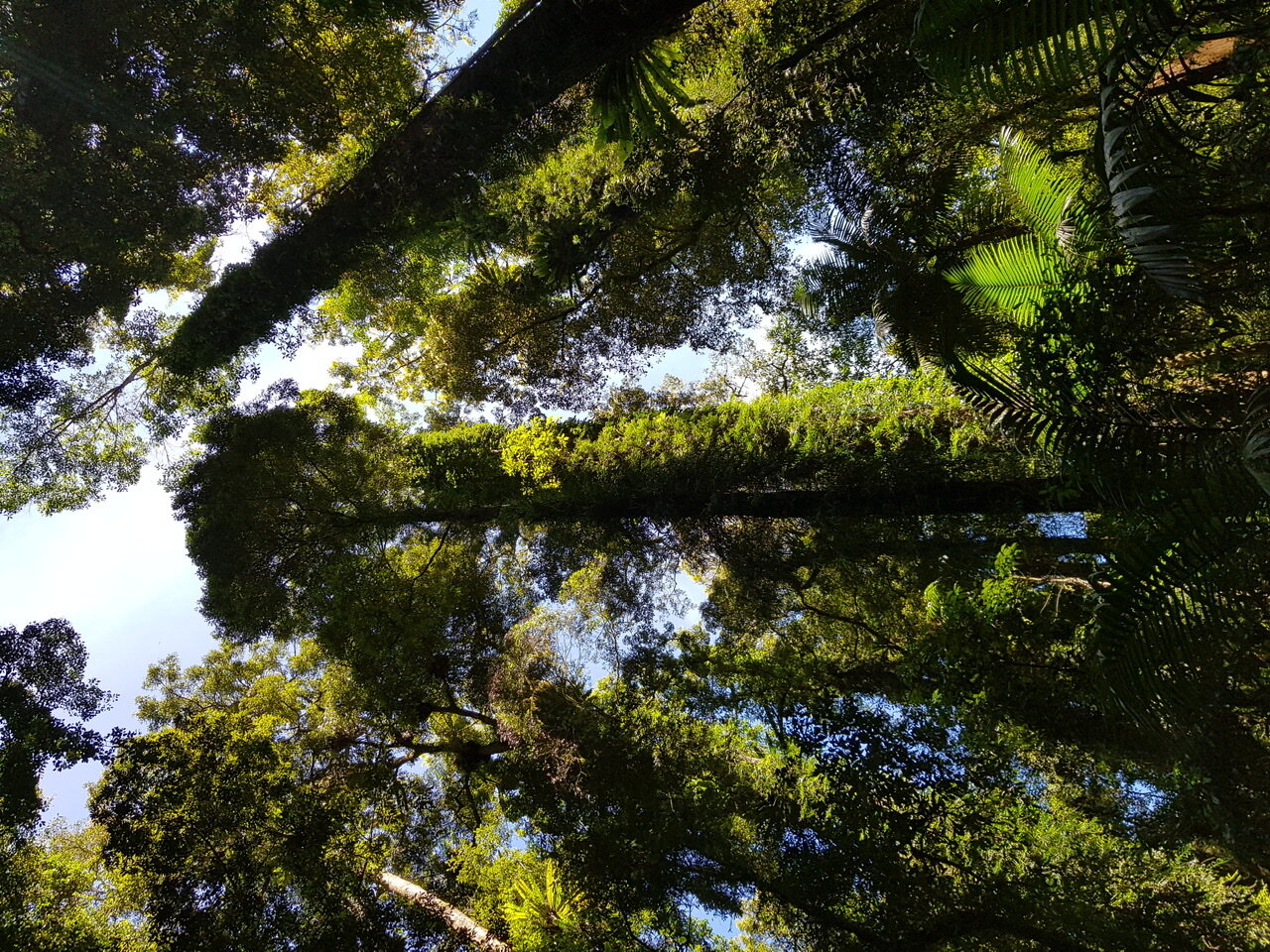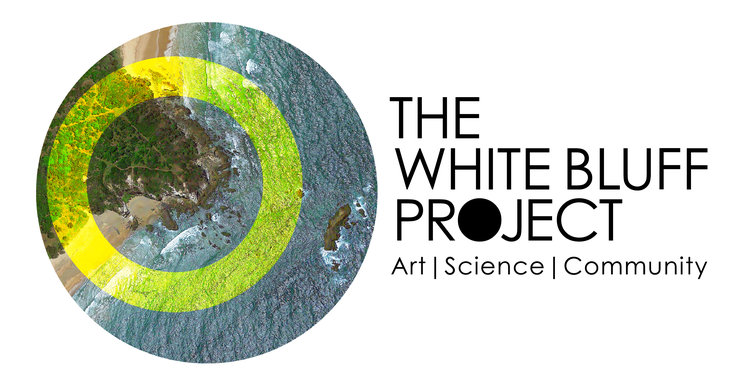White Bluff is a living, breathing, vibrant pocket of land. If you visit the Bluff at sunrise chances are you will find wallabies escaping into the rainforest scrub, brush turkeys foraging, white-bellied sea eagles and brahminy kites hunting the coastline. You will see banksias flowering, their nectar warming with the morning sun, and below the Bluff hang strings of yellow necklacepod or silverbush (Sophora tomentosa) an Endangered Species clinging to the coastal wrack line and slowly reclaiming its place in nature.
For all participants in the White Bluff Project, the diversity and sense of discovery in this small patch of protected land has been brought to life by one of our most passionate and inspiring science collaborators, Ecologist Mark Graham.
At first sight, White Bluff appears to be a remarkably unremarkable place - a small rocky headland surrounded by development on its landward edge. It is public land - largely unknown and typical of a string of isolated coastal ecosystems along Australia's increasingly inhabited eastern seaboard. At the start of the project, White Bluff had no recognised national significance and it was exactly this that attracted us all - these seemingly anonymous places are such a shared experience of place in Australia.
But interaction with Mark has revealed how common it is to find remarkable things in seemingly unremarkable places. The site’s ancient and unique heritage was detailed in an earlier News story on our website - A journey through Deep Time.
And most recently Mark has been at the centre of another exciting discovery in a fragment of forest in the nearby Korora Basin. The discovery of a new species of Fontainea, has been for him one of the most remarkable moments in his long career. It speaks precisely to the importance of projects like White Bluff.
“In reference to all the conversations and everything we have done on the White Bluff Project, this one plant distills it all down to one very very pointy end. This is what it is about. These fragments of land may look like nothing much, they may seem anonymous, they might be your local patch of scrub beside the highway or on your headland but, look what they could hold."




The new species of Fontainea is hidden amongst a small pocket of remnant rainforest - the last fragment of the luscious lowland tropical rainforests that once spread along our east coast. Previous distribution, Mark explains, may have been from the Boambee Valley, along the coastal foothills to Coffs Creek, the Korora Basin and to Moonee, growing on easterly to nor-easterly facing aspects with warm microclimates and fertile soils. At this stage the newly discovered Fontainea is known simply as the Coffs Harbour Fontainea. It is yet to be scientifically described. It shares its unique patch of forest with a Rusty Plum, another endangered species. There’s a towering hoop pine laden with epiphytes and a huge strangler fig. There is a red bean, a close relative of rosewood, and there’s a yellow tulip. Then, Mark explains, there’s two of the Small Bolwarra’s (or Native guava). The southern-most individual of this species is at Taylors Arm (Mark located it in 2001) and it extends north southern Queensland.
"They are amongst the most primitive floral structure of any genus. There are two species; the bolwarra and the small bolwarra and they are pollinated by a genus of really ancient beetles that eat the petals and spread the pollen."
At this stage the Coffs Harbour Fontainea is known from just five adult plants - 4 males and one female who now bears the burden for the survival of her entire species. Tiny babies surround her, poking their heads above the leaf litter, two small fruit are forming on one of the lower branches. She is doing her utmost to survive.
“There are maybe 20 babies but already a couple may have died,” explains Mark. He has made several trips to visit the female plant, keeping a close eye on her precious progress.
The Coffs Harbour Fontainea requires male and female plants for a viable population and potentially the plants are pollinated by insect and wind but so little is known about Fontaineas. The nearest species to this newly discovered one is the Coastal Fontainea at Lennox Head. Mark explains that many years have been spent on trying to get it out of its critically endangered status. This last remaining female of the Coffs Harbour Fontainea could also be many centuries old. They are slow growers and a quiet, unremarkable looking understorey dweller. Mark explains how the distribution of the genus can be tracked along the Australian coast with this new Coffs Harbour Fontainea being the most southerly. Every 100km to 150km northwards you then encounter another narrow endemic Fontainea, with many occupying tiny ranges.
“It starts here in the Korora Basin. We are about 160km south of Lennox. There are 10 plants or so at Lennox. Then in the ring around the Wollumbin shield is Fontainea australis, the southern Fontainea, maybe 250 plants in the wild. Then you go over the Queensland border and there are 7 species, many of them endangered or critically endangered, then there are two species in PNG and there are 4 species in New Caledonia.
“So what that is telling us is, it has an ancient lineage because that distribution indicates a life, an origin, measured in millions of years. There is a lot of interest in doing the genetic and biomedical work because Fontainea picrasperma has a dog anti-cancer drug developed from it and phase 2 human trials have shown that it is effective.”
According to Mark, researchers in this area have stressed how important it is that the plant needs to be left in the wild because the wild processes give the widest range of compounds. It needs to dwell where it is so it can be bio-prospected.
Mark’s enthusiasm and passion for nature has meant this new discovery is a highlight of his career and something he is keen to share with the wider community. Primarily because those 5 Fontaineas lie in the path of the approved Coffs Harbour Pacific Highway Bypass. A detailed story about the impact this may have on the highway and plans to protect the species can be found on the ABC news website.
Meanwhile, Mark has continued inspiring our White Bluff project team with his positivity, love of nature and his deep knowledge of the local area. Mark has worked across government, industry, and community and with many Aboriginal nations in northern NSW as an ecologist, elected representative, educator and business leader to protect, restore and rebuild country and culture. He is an accomplished educator and over many years in this capacity he has worked to highlight to residents of the region the global significance of our local land and seascape.
One of the longest-term and greatest accomplishments of Mark’s life has been the collaboration with the community and the Gumbaynggirr nation to protect the South Moonee Forest that immediately adjoins White Bluff. This area is the single most important bastion of biodiversity along the Northern Beaches of the Coffs Coast and Mark’s collaboration with Indigenous and non-Indigenous folk in this landscape has resulted in permanent protection of this nationally significant landscape. This landscape now provides myriad opportunities for supporting and rebuilding Indigenous cultural practices and for maintaining and restoring an astonishing natural heritage legacy in a sea of recent urban sprawl.



He has also been deeply involved with the campaign to save the Kalang Headwaters, as a spokesperson and also as part of the citizen science team that documented populations of koalas, greater gliders and potoroos that Forestry surveys had failed to find. But the unprecedented bushfires that ravaged national parks and nature reserves on the Mid North Coast in September 2019 propelled him onto the national, and the international, stage.
As he personally, and physically, battled fire burning through Gondwana rainforest at Mt Hyland and Billys Creek, Mark was simultaneously taking phone calls from metropolitan media working on stories about the challenge of bushfires in the age of climate change and talking about fighting fires in rainforest that had not evolved to burn. As the fires worsened across the country and the plight of our forests went global, Mark was called upon by international media as they used our country as an example of what a hotter and drier world with more ferocious droughts and fires could look like.
Since those hectic and traumatic days Mark has moved away from the intense international limelight to once again focus on what he loves most - the unique ecosystems right on our doorstep.
Last year, Mark launched Bellingen Nature Tours and he now offers small group, exclusive and deeply immersive nature experiences with day-tours from Bellingen along the Great Escarpment to the highest peaks of the Dorrigo Plateau and the gorges of the Clarence River. The Bellingen Nature Tours social media feed on Instagram is a smorgasbord of beautiful scenery, encounters with wildlife and immersive soundscapes.
“Each tour is unique and planned around your needs and interests and numbers are small, generally maximum of 3-5. We have access here to the cleanest of water and air and a riotous profusion of biodiversity. The lowlands of the Bellinger Valley have some of the biggest and most impressive subtropical rainforests and the tallest eucalypt forest in NSW,” Mark explains.
“It’s a remarkable thing to have on our doorsteps. We truly are custodians of globally significant biodiversity.”

